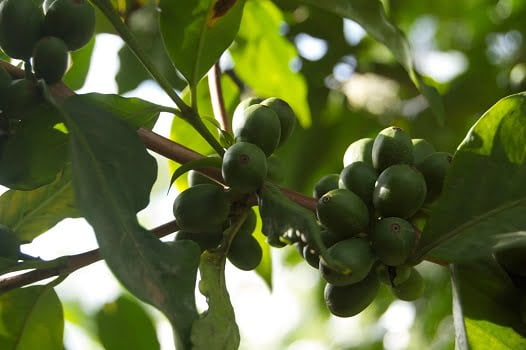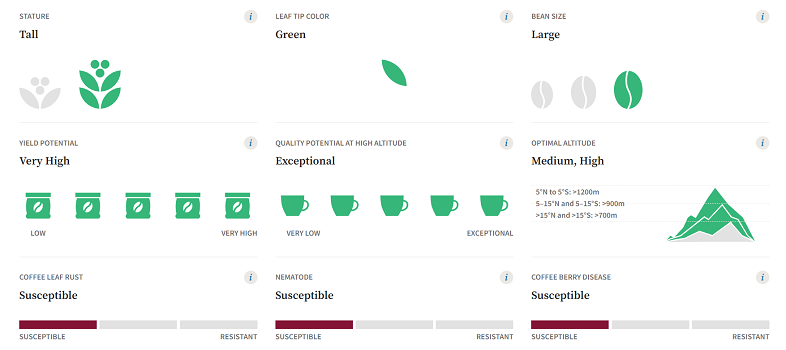In the coffee world, where each bean tells a tale of its origin, SL 28 and SL34 from the Coffea Arabica Family stand out as charismatic characters with roots tracing back to rich Kenyan Soil.
SL varieties were first developed in the 1930s at the Scott Agricultural Laboratories in Kenya. Researchers were looking for disease-resistant, high-yielding varieties that could thrive in Kenya’s climate.
SL 28 became prized for its sweet, complex flavor with wine-like overtones. SL 34 gained favor for its full body and pleasant acidity. These attributes made them a hit with specialty coffee buyers around the world.

As an Amazon Associate, I earn commission from qualifying purchases.
A Brief History of SL Coffee Varieties
The prized SL coffee varieties we know today trace back to 1920s Kenya under British colonial rule.
SL refers to Scott Laboratories which was established at that time to research coffee cultivation in the climate of Kenya.
The goal was to find coffee varieties that would thrive in Kenya – producing higher yields and resisting droughts and pests.
Researchers made selections from old Arabica coffee varieties like Typica and Bourbon, grafting trees and testing them extensively.
Today, the SL cultivars developed by Scott Labs in the 1930s make up 80% of coffee production in Kenya and are also grown in some other Eastern African and Latin American Countries.

The Characteristics of SL 28 Coffee Varietal
SL28 is one of the most renowned coffee cultivars from Africa. It’s related to the Bourbon-Arabica family, with tall trees, green leaves, and large cherries. This variety thrives at medium to high altitudes and requires little maintenance.

The plants are quite hardy – they can withstand years of neglect and still bounce back to produce delicious beans.
That’s why you can still find productive SL28 trees that are 60-80 years old!
However, SL28 is susceptible to common coffee diseases like leaf rust and coffee berry disease.
Flavor-wise, SL28 is complex and unique. It delivers dazzling acidity reminiscent of black currant or fresh summer tomatoes. The juicy body and super sweet, tropical tastes make SL28 a favorite among specialty coffee aficionados.
The Characteristics of SL 34 Coffee Varietal
SL 34 is genetically related to the Typica-Arabica Family and thrives in high-altitude regions with ample rainfall. The plants have dark bronze shoot tips and semi-erect laterals that can droop on older branches. SL34 tends to have tall trees and large beans.

SL34 is highly susceptible to major coffee diseases like leaf rust, coffee berry disease, and nematodes. However, It doesn’t require careful monitoring and can thrive with minimal care.
When grown well, SL34 delivers a complex, citrusy acidity with a heavy mouthfeel and clean, sweet finish. The flavors often have bright acidity paired with deep chocolate and smoky notes.
The Prized Cup Profile of SL 28 and SL 34
Kenya has long been renowned for producing some of the world’s best coffee.
There are many taste similarities between SL28 and SL34, with both featuring complex fruit notes balanced by sweetness. The cup profile is very rich with bright acidity, and nutty, berry-like undertones.
These varieties are often processed using the washed method, which complements their dark berry and wine-like flavors.
It’s no wonder the Alliance for Coffee Excellence has ranked these cultivars in the top 10 exotic coffees, with cupping scores over 90.
When grown and processed well, SL28 and SL34 exemplify the floral, fruity profile that makes Kenyan coffee so prized.
Check out What country has the best coffee
The Future of SL 28 and SL 34 Coffee Varieties
SL28 and SL34 are the most viable Arabica varieties that offer high yields and exceptional cup quality but remain susceptible to major coffee diseases like leaf rust, nematodes, and coffee berry disease.
This represents a risk for farmers who can lose entire crops.
While the plants are productive, much income goes back into maintenance and covering losses.
Some farms are shifting to more resistant varieties like Batian and Ruiru 11, though these compromise a bit on cup quality.
Still, SL varieties remain popular across Kenya today due to their prized flavor profiles. Balancing disease resistance and taste will be key to their future sustainability.
Discover Guides on other Coffee beans
Final Thoughts
And there you have it – the full story on Kenya’s legendary SL28 and SL34 coffee cultivars. From their inception at Scott Labs to their prized flavor profiles, these varieties have cemented their status as some of the most sought-after coffees in the world.
So what do you think? Have you tried these famous Kenyan Arabica varieties before? Let me know in the comments which one is your favorite and why. I’d love to hear about your tasting experiences with these amazing varietals.
Check out the different coffee bean types
FAQs
What is the difference between SL 28 and SL 34?
The main difference in SL28 is related to the Bourbon family, while SL34 is related to Typica.
In terms of taste, I’m definitely an SL 28 fan. The sweet, complex flavors with hints of black currant and chocolate create an incredibly lush, syrupy body that lingers on the palate.



